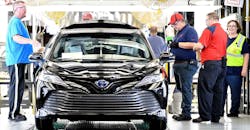What do you do when immense changes are sweeping your industry at a pace never experienced before? When you’re facing competitors never before on the radar? When you’re an industrial giant that’s experienced huge success, to such a degree that the eyes of other industrial giants are glued to how you get things done?
If you’re Toyota, you jump right in, you revisit the basics and you pump up the speed.
What?
Toyota Motor Corp. President Akio Toyoda has made no secret of just how radical the changes are he sees sweeping the automotive industry. Unprecedented, he says. Unparalleled, he suggests. Not about merely winning or losing, says the grandson of the founder of Toyota Motor Corp., but a battle for survival.
He’s talking about rapid-fire advances in technology—automotive electrification, vehicle connectivity that is growing by leaps and bounds to full autonomy, the advent of car-sharing versus car-owning—as well as new competitors from the Googles of the world who are outside of automotive altogether.
“The automotive industry is now hurtling into an era of profound transformation, the likes of which come only once every 100 years,” Toyoda said during a press conference that coincided with the automaker’s last fiscal year-end. “With even our rivals and the rules of competition also changing, a life-or-death battle has begun in a world of unknowns.”
So how is Toyota addressing this “once-in-a-century profound transformation”? Certainly, like every other auto and technology company that wants to own this space—by leaping into all the new stuff. By reinventing the wheel. But also, and significantly, by going back to what got it there.
And for Toyota, what got it there is the Toyota Production System, or TPS—the vaunted production system developed by Toyota to make vehicles to customer order as quickly and as efficiently as possible by eliminating waste. That means building quality into the manufacturing process and improving productivity by making only, in the company’s own words, “what is needed, when it is needed, and in the amount needed.” Additionally, the philosophy of daily continuous improvements is inextricably intertwined in TPS.
It would be difficult to overstate the influence of the Toyota Production System on manufacturing well beyond Toyota. TPS has been the model for countless other manufacturing companies’ production systems, both inside and outside of automotive. As well, the root of lean manufacturing is the Toyota Production System.
Its proponents are legion. Here are just a few comments gleaned from a LinkedIn request for comment on the influence of TPS:
“I’ve been in the manufacturing sector my entire career. In the past three decades, the Toyota Production System has become the benchmark of manufacturers worldwide,” wrote Terry Spalding, continuous improvement manager at Hansen Plastics, with past leadership positions across a range of manufacturing operations. “TPS is the breakthrough philosophy for manufacturers and service industries who want to excel and be relevant far into the future.”
“[TPS] has forced all players to dramatically improve,” adds consultant and IndustryWeek contributor Robert Simonis.
“Profound would be an understatement! If you’re not doing TPS as a manufacturer, you’ll soon be out of business. As for automotive, even more true,” added a lean and continuous improvement engineer with Sandia National Laboratories.
TPS in Every Corner of the Business
At Toyota, TPS is simply how the company operates, and about a year ago the automaker introduced a newly created TPS group to “consolidate the strengths of Toyota, with an aim to improve productivity in areas outside of production by promoting the Toyota Production System in such areas.”
The task of the group, according to its then-leader Shigeki Tomoyama, was to evaluate how TPS’ core concepts, such as continuous improvement, could be applied to the company’s newer businesses, such as car-sharing and connected vehicles. As president of Toyota Connected Corp., as well as a Toyota executive vice president, Tomoyama is intimately engaged with Toyota’s transformational efforts.
“We want to systematically go over every step in our processes—from R&D to manufacturing, sales and servicing—in order to raise the combat effectiveness of our business as a whole,” Tomoyama told Bloomberg in an interview early last year. “The backdrop to all this is President Toyoda’s extremely strong sense of crisis.”
That said, the idea of Toyota taking TPS from its shop floor and disseminating it elsewhere is not a radically new idea for the company.
“In some ways, this is just a continuation of a theme that has gone on about 50 years,” says Art Smalley, lean consultant and author of several books including his most recent, Four Types of Problems: from reactive troubleshooting to creative innovation. Smalley is among a small number of Americans who have worked for Toyota in Japan.
To illustrate his words, Smalley points to an internal Toyota document that outlined the formation of a new group to spearhead taking the production system beyond the shop floor. The date of that document: 1969.
Back then, the aim was to expand TPS off the shop floor and out to the supply base. Then came a drive to expand TPS to other departments within the company. Now comes this latest TPS expansion.
“This is the fourth wave, if you consider the first wave [TPS on] the shop floor,” Smalley says. “Now they are saying, ‘even farther.’”
Indeed, Toyoda has outlined the necessity for TPS within the company’s new businesses. “What will be required in the era to come is anticipating customer needs and providing customers with more personal mobility in a more direct and timely manner,” he said in May. “In other words, it will be a world in which the services that are needed are provided when needed and only in the amount needed. Such is precisely a world of ‘just in time,’ as found in TPS.”
“To realize ‘just in time’ services, simply linking automobiles to networks is not enough," he said. "It is necessary that all manufacturers, dealers and alliance partners that provide services are connected to each other through waste-free, lean operations.”
Over the past year, Toyota has been incorporating the TPS philosophy across several of its newer businesses, including taking JIT thinking to its dealerships, where data collected from Toyota’s connected cars ideally can both speed maintenance and reduce wait times for customers. The company is taking a kaizen, or continuous small improvements, approach to each operation process to deliver those services faster and better. Moreover, teams have been dispatched to several Toyota Motor divisions to spread the kaizen philosophy.
“These activities are steadily moving forward,” the company said.
It’s About Agile, Too
For all its benefits, Robert Kluttz suggests the long-term sustainability of TPS will be tested over the next decade. “Toyota has already changed their strategic approach in response to disruption from other manufacturers as well as other industries. Shorter development lifecycles and enabling for extreme car-by-car customization aren’t TPS strengths,” said Klutz, who is head of quality and transformation (oncology) at healthcare provider GenesisCare. “It wouldn’t be surprising to see Toyota adapting more to what’s going on in their industry than the industry adapting to what’s going on at Toyota.”
It sounds like Toyota may agree, to an extent. Listen to Nigel Thurlow, chief of agile at Toyota Connected, where the name of the game is reimagining the use of data and technology in the age of mobility. That means delivering “effortless services that make life easier and driving safer, more convenient and fun.”
“We have to change. We must become much more like IT companies before IT companies become more like us,” Thurlow said in a presentation he gave last October at the Lean Digital Summit. “We are not the only people building cars anymore. The automotive industry is not the only industry building cars.”
“[TPS] is not enough from the point of view of where the company is going," he added. In short, TPS is not responsive enough. “The way we use vehicles is going to change over the next few years” as well as decades, Thurlow said, “and we need to become very agile to be able to respond to this.”
Moreover, people want instantaneous fixes. He pointed to Tesla, able to roll out big software updates, for free, over the air. Recalls of the early Prius cars for software updates, by comparison, were lumbering affairs.
“We need to respond,” Thurlow said.
At Toyota Connected and beyond, teams are responding. They are taking an agile approach to development. Adopted from the software industry, agile “is about enabling business agility, enabling your organization to respond to change rapidly,” Thurlow said. “One of the key values from the agile manifesto is responding to change over following a plan.”
Ultimately, agile is about working differently, the chief of agile said, and outlined key components of agile during his presentation: scrum as a framework, one-week development sprints, rapid voice-of-the-customer feedback. Iterate, iterate, iterate. If some of this sounds familiar, perhaps it should. There is an interesting historical connection between TPS, scrum and agile, which Thurlow detailed during his presentation.
He also shared some numbers. A group of teams supporting Toyota North America manufacturing reduced the average time-to-deliver on small projects to 69 days from an average of 186 days by taking an agile approach. A team in shared services accelerated the time to build a simple web server from 11 weeks to two days.
Thurlow noted that it’s possible to be lean without being agile. Similarly, it’s possible to be agile without being lean. “I posit that you want to be both lean and agile,” he said.
Most of all, you want to be in the game. So, what do you do when immense changes are sweeping your industry at a pace never experienced before? If you’re Toyota, you jump right in, you revisit the basics and you pump up the speed.
About the Author
Jill Jusko
Bio: Jill Jusko is executive editor for IndustryWeek. She has been writing about manufacturing operations leadership for more than 20 years. Her coverage spotlights companies that are in pursuit of world-class results in quality, productivity, cost and other benchmarks by implementing the latest continuous improvement and lean/Six-Sigma strategies. Jill also coordinates IndustryWeek’s Best Plants Awards Program, which annually salutes the leading manufacturing facilities in North America.
Have a story idea? Send it to [email protected].

